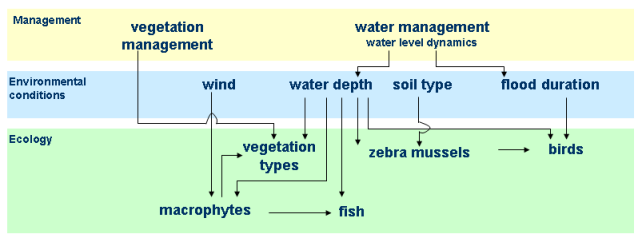In order to use HABITAT for ecological effect analysis, we propose to follow the following steps:
In order to use HABITAT for ecological effect analysis, we propose to follow the following steps:
1) Determine the objective of the use of HABITAT.
What question do you want to answer?
For example: What are the effects of changes in water level fluctuation on ecology?
2) Make the question more specific in terms of ecological parameters.
For example: What are the effects in terms of suitable habitat for macrophytes and the Rhodeus sericeus amarus ?
3) Describe the habitat requirements for the species or group of species.
In other words: describe the environmental conditions needed.
For example (in short):
The growth of submerged macrophytes is mainly determined by light availability. The light availability is influenced by algae concentration, suspended sediment, detritus and humus acids. Furthermore, the sediment type and salt concentration determine the growth of macrophytes. Wind fetch sometimes disturbes the growth of macrophytes, although submerged macrohytes are less limited by this. In some areas the feeding of birds on macrophytes is an important limiting factor, especially in period late summer to autumn.
Determine also what the most important factors are for the occurrence of a (group of) species. Consider whether these factors are enough to answer the central question of the study.
4) Analyse the Effect chain. How does the pressure, autonomic development or water management strategy affect the habitat suitability directly or indirectly? A direct influence is for example: the grazing by birds or land use management by mowing. Indirect effects are all the effects via the environmental conditions. For example, changes in water level result in changes in water depth, which is an important environmental condition for macrophytes. A more complex example is given in the figure below.

Reconsider the selected environmental factors for the habitat requirements. Are the most important factors to assess the effects of the scenario and/or management strategy included in both the habitat requirements and process effect chain?
5) Import response curves from the ecological knowledge base or make your own response curves.
Make your own response curves in HABITAT:
Learn more about Modeltypes and configuring them.
6) Make the calculation.
You may either run
To do this right click at a model, composite model or project or select from the menu _Run, Run all models.
7) Analyse results.
See also the quickstart movies on how to use the user interface of HABITAT.
To List of contents
HABITATDOC:To top of page